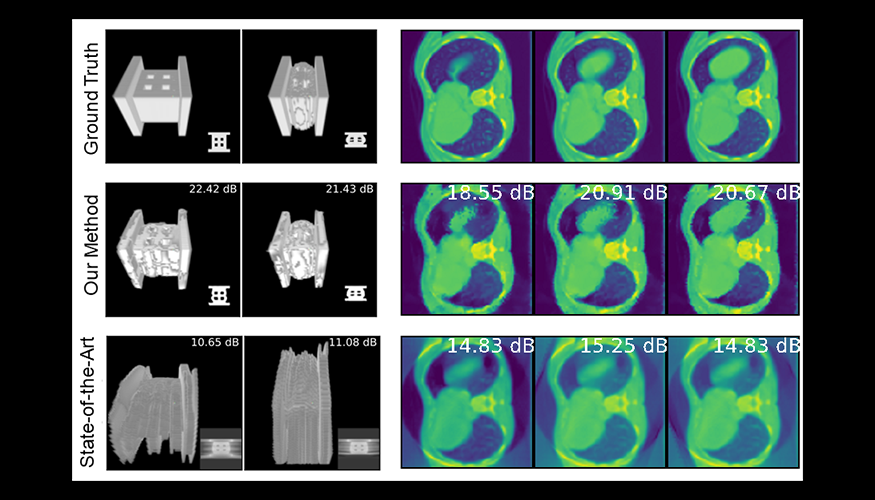DINR, v1.0 (Distributed Implicit Neural Representation)
LLNL’s Distributed Implicit Neural Representation (DINR) is a novel approach to 4D time-space reconstruction of dynamic objects. DINR is the first technology to enable 4D imaging of dynamic objects at sufficiently high spatial and temporal resolutions that are necessary for real world medical and industrial applications.
The software does 4D time-space reconstruction of dynamic objects scanned using X-ray computed tomography (CT).
Background
X-ray computed tomography (CT) is commonly used to acquire 3D volumetric imaging of static objects. This makes the technique very useful in aerospace, automotive, electronics industries when inspecting parts for defects such as voids, cracks, porosity and inclusions. CT is also used in clinical settings to diagnose disease or injury as well as plan treatments for patients.
A requirement for conventional x-ray CT scanning is that the object (or patient) has to remain relatively still during the time it takes for the equipment to complete the scan rotation and collect the data. If the object is in motion or dynamically changing significantly over time, current technologies cannot scan and acquire the data quickly enough, thus reconstruction of the image data is severely degraded with reconstruction artifacts.
Hence, there is a strong need for new technologies that enable 4D CT imaging of dynamic objects with time resolution that approaches the time taken for one X-ray image acquisition. Such a new capability is useful for many applications as it essentially is capturing a 3D movie showing internal motion from any point of view of a beating heart or the lungs during while a patient is breathing, in-situ imaging of fabricated component while undergoing mechanical testing, etc.
Description
LLNL’s Distributed Implicit Neural Representation (DINR) is a novel approach to 4D time-space reconstruction of dynamic objects. DINR is the first technology to enable 4D imaging of dynamic objects at sufficiently high spatial and temporal resolutions that are necessary for real world medical and industrial applications.
To be able to significantly decrease the time it takes to acquire a scan, DINR uses a neural network to predict an object’s X-ray attenuation properties as a function of the time and space coordinates. The novel distributed training algorithm optimizes the parameters of this neural network such that the forward model fits the measured data. LLNL’s forward model is a model for the X-ray physical measurement process that is dependent on the imaging geometry and system parameters.
DINR is highly scalable for distributed training on several hundreds of GPUs with near linear scaling performance.
Advantages
- Enables high resolution 4D imaging of dynamic objects
- Continuous CT projection offers flexibility and scalability in the optimization process
- Requires less computing resources and smaller memory footprint compared to existing approaches
- Increase in volume dimensions of reconstructions that can range from gigabytes to terabytes

-
expand_more library_books References (2)
- Reed, A. W., Kim, H., Anirudh, R., Mohan, K. A., Champley, K., Kang, J., & Jayasuriya, S. (2021), Dynamic CT Reconstruction from Limited Views with Implicit Neural Representations and Parametric Motion Fields
- Mohan, K. A., Ferrucci, M., Divin, C., Stevenson, G. A., & Kim, H. (2024), Distributed Stochastic Optimization of a Neural Representation Network for Time-Space Tomography Reconstruction
-
expand_more cloud_download Supporting documents (0)Additional files may be available once you've completed the transaction for this product. If you've already done so, please log into your account and visit My account / Downloads section to view them.